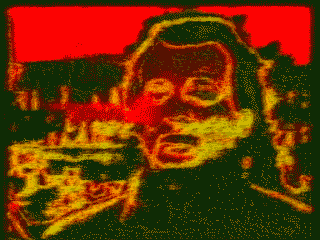VIDEO IN THE ABYSS
IN THE CONTEXT OF THE DIGITAL, IS ANALOGUE VIDEO FEEDBACK STILL USEFUL AS AN APPROACH TO MAKING ART?
SAM MEECH - MASTERS OF ARTS RESEARCH PROJECT - 2018-2020
thesis download: ResearchGate / Adcademia.edu / google drive
ABSTRACT
Video feedback systems have been largely discounted by media artists in favour of digital tools and code-based programming languages, which offer a more robust, data-driven approach to developing generative and interactive moving image works. Furthermore, art historians have generally failed to document and reflect on the practice of video feedback. However, video feedback systems have many qualities that can enrich current digital culture, whilst digital tools provide an opportunity for artists to revisit analogue feedback from a fresh perspective.
This thesis and accompanying portfolio reappraises the use of feedback systems in media art, and explores their application in combination with digital tools such as projection mapping software. Through practice-based research, analysis of contemporary media art works, and interviews with artists and curators, this thesis identifies and analyses the key technological and experiential properties of video feedback installations from the perspectives of both artist and audience.
The works produced proved to be extremely engaging for audiences. Comments from experts within the field suggest that key factors include the mesmerising elemental forms and textures of feedback, and the intuitive nature of the interface. One work (PORTALS) was also shortlisted for the Lumen Prize for Art and Technology.
Video feedback works still present unique problems: they are difficult to calibrate, often unpredictable or even unrepeatable. However, this thesis concludes that there are significant benefits in revisiting this 50 year old video art technique from a contemporary digital perspective. Digital video tools offer new ways to generate, calibrate, and present video feedback in various contexts. Conversely, the incorporation of optical or analogue feedback into digital systems can offer a simple method of generating complex textures and chaotic behaviour without the need for programming skills, as well as providing an extremely intuitive interface for audience interaction via the video camera. The thesis ends by suggesting that more research needs to be done to examine how feedback installations can be made more robust and scalable across a range of contexts from white cube galleries to light festivals.
PORTFOLIO OF WORKS AND EXPERIMENTS
VIDEO IN THE ABYSS
IN THE CONTEXT OF THE DIGITAL, IS ANALOGUE VIDEO FEEDBACK STILL USEFUL AS AN APPROACH TO MAKING ART?
SAM MEECH - MASTERS OF ARTS RESEARCH PROJECT - 2018-2020
thesis download: ResearchGate / Adcademia.edu / google drive
ABSTRACT
Video feedback systems have been largely discounted by media artists in favour of digital tools and code-based programming languages, which offer a more robust, data-driven approach to developing generative and interactive moving image works. Furthermore, art historians have generally failed to document and reflect on the practice of video feedback. However, video feedback systems have many qualities that can enrich current digital culture, whilst digital tools provide an opportunity for artists to revisit analogue feedback from a fresh perspective.
This thesis and accompanying portfolio reappraises the use of feedback systems in media art, and explores their application in combination with digital tools such as projection mapping software. Through practice-based research, analysis of contemporary media art works, and interviews with artists and curators, this thesis identifies and analyses the key technological and experiential properties of video feedback installations from the perspectives of both artist and audience.
The works produced proved to be extremely engaging for audiences. Comments from experts within the field suggest that key factors include the mesmerising elemental forms and textures of feedback, and the intuitive nature of the interface. One work (PORTALS) was also shortlisted for the Lumen Prize for Art and Technology.
Video feedback works still present unique problems: they are difficult to calibrate, often unpredictable or even unrepeatable. However, this thesis concludes that there are significant benefits in revisiting this 50 year old video art technique from a contemporary digital perspective. Digital video tools offer new ways to generate, calibrate, and present video feedback in various contexts. Conversely, the incorporation of optical or analogue feedback into digital systems can offer a simple method of generating complex textures and chaotic behaviour without the need for programming skills, as well as providing an extremely intuitive interface for audience interaction via the video camera. The thesis ends by suggesting that more research needs to be done to examine how feedback installations can be made more robust and scalable across a range of contexts from white cube galleries to light festivals.













